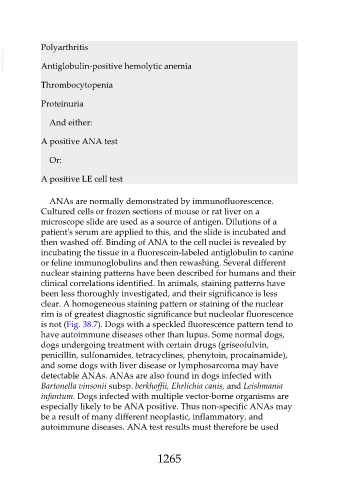Page 1265 - Veterinary Immunology, 10th Edition
P. 1265
Polyarthritis
VetBooks.ir Antiglobulin-positive hemolytic anemia
Thrombocytopenia
Proteinuria
And either:
A positive ANA test
Or:
A positive LE cell test
ANAs are normally demonstrated by immunofluorescence.
Cultured cells or frozen sections of mouse or rat liver on a
microscope slide are used as a source of antigen. Dilutions of a
patient's serum are applied to this, and the slide is incubated and
then washed off. Binding of ANA to the cell nuclei is revealed by
incubating the tissue in a fluorescein-labeled antiglobulin to canine
or feline immunoglobulins and then rewashing. Several different
nuclear staining patterns have been described for humans and their
clinical correlations identified. In animals, staining patterns have
been less thoroughly investigated, and their significance is less
clear. A homogeneous staining pattern or staining of the nuclear
rim is of greatest diagnostic significance but nucleolar fluorescence
is not (Fig. 38.7). Dogs with a speckled fluorescence pattern tend to
have autoimmune diseases other than lupus. Some normal dogs,
dogs undergoing treatment with certain drugs (griseofulvin,
penicillin, sulfonamides, tetracyclines, phenytoin, procainamide),
and some dogs with liver disease or lymphosarcoma may have
detectable ANAs. ANAs are also found in dogs infected with
Bartonella vinsonii subsp. berkhoffii, Ehrlichia canis, and Leishmania
infantum. Dogs infected with multiple vector-borne organisms are
especially likely to be ANA positive. Thus non-specific ANAs may
be a result of many different neoplastic, inflammatory, and
autoimmune diseases. ANA test results must therefore be used
1265

